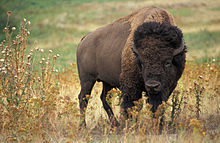- Plains bison
-
Plains Bison 
Conservation status Scientific classification Kingdom: Animalia Phylum: Chordata Class: Mammalia Order: Artiodactyla Family: Bovidae Genus: Bison Species: B. bison Subspecies: B. bison bison Trinomial name Bison bison bison
(Linnaeus, 1758)Synonyms Bison bison montanae
The Plains Bison (Bison bison bison) or Common bison is one of two subspecies/ecotypes of the American Bison, the other being the Wood Bison (Bison bison athabascae).[1][2][3][4][5][6] Furthermore, it has been suggested that the Plains Bison consists of a northern (Bison bison montanae) and a southern subspecies, bringing the total to three.[4] However, this is generally not supported.
Contents
Reintroduction of herds
Plains Bison have been introduced into a number of locations around North America. The farthest north introduction occurred in 1928 when the Alaska Game Commission brought bison to the area of present day Delta Junction. Bison taken from this transplant were also introduced to other Alaska locations, including Farewell and Chitina. The Delta Junction herd has fared best, with a population of multiple hundreds throughout the late 20th century. This herd is popular with hunters interested in hundreds of pounds of high quality meat, but has been a problem for farming operations in the area.
In 2006, Plains Bison from Elk Island National Park in Alberta were released into Grasslands National Park in Saskatchewan. This marks the first time Plains Bison have wandered the shortgrass prairies of Canada since their near-extinction at the turn of the 20th century.
A herd of approximately 550 of these animals lives in, and can be seen at, the Wichita Mountains Wildlife Refuge near Lawton, Oklahoma. The herd was started in 1907 with stock from the Bronx Zoo[clarification needed]. Fifteen animals were shipped to Oklahoma, where they had already become extinct due to excessive hunting and over harvesting by non-Native commercial buffalo hunters from 1874 to 1878.
Uses
Besides using the meat, fat, and organs for food, Plains tribes have traditionally created a wide variety of tools and items from bison. These include arrow points, awls, beads, berry pounders, hide scrapers, hoes, needles from bones; spoons from the horns; bow strings and thread from the sinew; waterproof containers from the bladder; paint brushes from the tail and bones with intact marrow; cooking oil from grease.[7] Skulls can be used ceremonially as altars. Rawhide is used for parfleches, shield covers, and moccasin soles. Hides with the fur is used for blankets, wraps, and warm clothing. Tanned hides, the finest of which are tanned with the animal's brains and then smoked, are used in clothing, moccasins, tipi covers, calendars, and artwork.
See also
- Plains hide painting
- Red River War
References
- ^ Geist V. (1991). "Phantom subspecies: the wood bison, Bison bison "athabascae" Rhoads 1897, is not a valid taxon, but an ecotype.". Arctic 44 (4): 283–300.
- ^ Kay, Charles E.; Clifford A. White (2001). "Reintroduction of bison into the Rocky Mountain parks of Canada: historical and archaeological evidence". Crossing Boundaries in Park Management: Proceedings of the 11th Conference on Research and Resource Management in Parks and on Public Lands. Hancock, Michigan: The George Wright Society, Inc.. pp. 143–151. http://www.georgewright.org/24kay.pdf. Retrieved December 2, 2009.
- ^ Bork, A. M., C. M. Strobeck, F. C. Yeh, R. J. Hudson, & R. K. Salmon (1991). "Genetic relationship of wood and plains bison based on restriction fragment length polymorphisms". Can J Zool 69 (1): 43–48. doi:10.1139/z91-007. http://article.pubs.nrc-cnrc.gc.ca/RPAS/RPViewDoc?_handler_=HandleInitialGet&calyLang=eng&journal=cjz&volume=69&articleFile=z91-007.pdf.
- ^ a b Halbert, Natalie D., Terje Raudsepp, Bhanu P. Chowdhary, & James N. Derr (2004). "Conservation Genetic Analysis of the Texas State Bison Herd". Journal of Mammalogy 85 (5): 924–931. doi:10.1644/BER-029. http://www.bioone.org/doi/full/10.1644/BER-029.
- ^ Wilson, G. A., & C. Strobeck (1999). "Genetic variation within and relatedness among wood and plains bison populations". Genome 42 (3): 483–496. doi:10.1139/gen-42-3-483. PMID 10382295. http://article.pubs.nrc-cnrc.gc.ca/ppv/RPViewDoc?issn=0831-2796&volume=42&issue=3&startPage=483.
- ^ Boyd, Delaney P. (2003). Conservation of North American Bison: Status and Recommendations (MS thesis). University of Calgary. http://www.notitia.com/bison/Members/PDF%20Files/Library/Thesis%20Document%20-%20Conservation%20Status%20of%20Bison%20-%20BOYD.pdf. Retrieved December 2, 2009.
- ^ Hunt, David. Native Indian Wild Game, Fish, and Wild Foods Cookbook. Lancaster, PA: Fox Chapel Publishing, 1992: 41. ISBN 1-56523-008-6.
External links
Categories:- IUCN Red List conservation dependent species
- Bison
- Animals described in 1758
- Mammals of North America
- Fauna of the United States
- Megafauna of North America
- Native American cuisine
Wikimedia Foundation. 2010.

